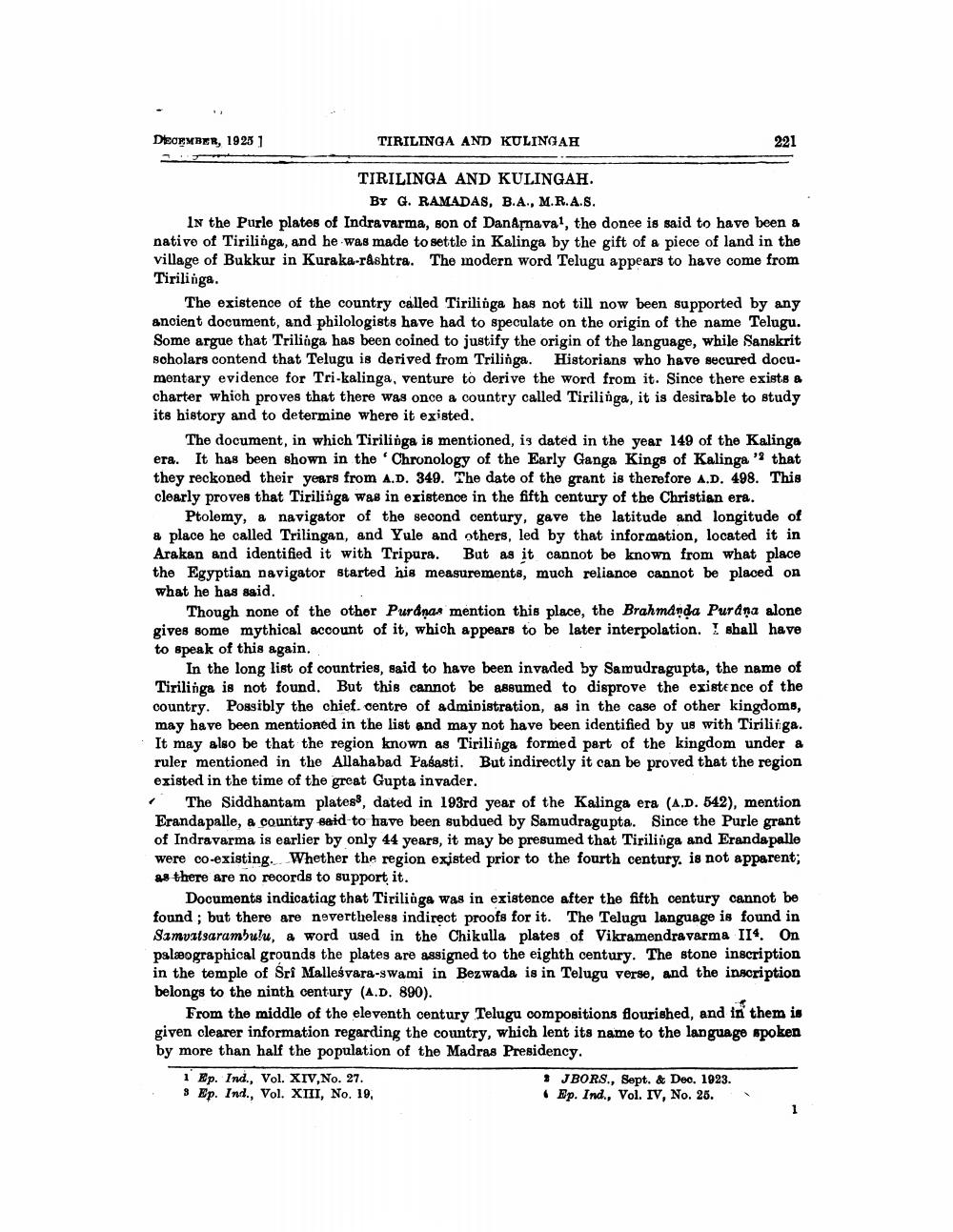________________
DIEOEMBER, 1925 1
TIRILINGA AND KULINGAH
TIRILINGA AND KULINGAH.
By G. RAMADAS, B.A., M.R.A.S. In the Purle plates of Indravarma, son of Danamaval, the donee is said to have been & native of Tirilinga, and he was made to settle in Kalinga by the gift of a piece of land in the village of Bukkur in Kuraka-rashtra. The modern word Telugu appears to have come from Tirilinga.
The existence of the country called Tiriliiga has not till now been supported by any ancient document, and philologists have had to speculate on the origin of the name Telugu. Some argue that Trilinga has been coined to justify the origin of the language, while Sanskrit scholars contend that Telugu is derived from Trilinga. Historians who have secured documontary evidence for Tri-kalinga, venture to derive the word from it. Since there exists & charter which proves that there was once a country called Tirilinga, it is desirable to study its history and to determine where it existed.
The document, in which Tiriliiga is mentioned, is dated in the year 149 of the Kalinga era. It has been shown in the 'Chronology of the Early Ganga Kings of Kalinga'that they reckoned their years from A.D. 349. The date of the grant is therefore A.D. 498. This clearly proves that Tiriliiga was in existence in the fifth century of the Christian era.
Ptolemy, a navigator of the second century, gave the latitude and longitude of a place he called Trilingan, and Yule and others, led by that information, located it in Arakan and identified it with Tripura. But as it cannot be known from what place the Egyptian navigator started his measurements, much reliance cannot be placed on what he has said.
Though none of the other Purdnas mention this place, the Brahmanda Purana alone gives some mythical account of it, which appears to be later interpolation shall have to speak of this again.
In the long list of countries, said to have been invaded by Samudragupta, the name of Tirilinga is not found. But this cannot be assumed to disprove the existence of the country. Possibly the chief. centre of administration, as in the case of other kingdoms, may have been mentioned in the list and may not have been identified by us with Tiriliiga. It may also be that the region known as Tirilinga formed part of the kingdom under & ruler mentioned in the Allahabad Pasasti. But indirectly it can be proved that the region existed in the time of the great Gupta in vader.
The Siddhantam plates, dated in 193rd year of the Kalinga era (A.D. 542), mention Eranda palle, a country said to have been subdued by Samudragupta. Since the Purle grant of Indravarma is earlier by only 44 years, it may be presumed that Tirilinga and Eranda palle were co-existing. Whether the region existed prior to the fourth century, is not apparent; as there are no records to support it.
Documents indicatiag that Tiriliiga was in existence after the fifth century cannot be found; but there are nevertheless indirect proofs for it. The Telugu language is found in Samvatsarambulu, a word used in the Chikulla plates of Vikramendravarma II4. On palæographical grounds the plates are assigned to the eighth century. The stone inscription in the temple of Sri Malleśvara-swami in Bezwada is in Telugu verse, and the inscription belongs to the ninth century (A.D. 890).
From the middle of the eleventh century Telugu compositions flourished, and in them is given clearer information regarding the country, which lent its name to the language spoken by more than half the population of the Madras Presidency. 1 Ep. Ind., Vol. XIV, No. 27.
3 J BORS., Sept. & Dec. 1923. 3 Ep. Ind., Vol. XIII, No. 19,
Ep. Ind., Vol. IV, No. 25.




